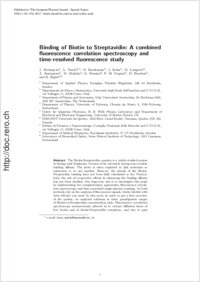Binding of Biotin to Streptavidin: A combined fluorescence correlation spectroscopy and time-resolved fluorescence study
- Strömqvist, J. Department of Applied Physics, Kungliga Tekniska, Stockholm,Sweden
- Nardo, L. Dipartimento di Fisica e Matematica, Università degli Studi dell’Insubria, Como, Italy
- Broekmans, a, O. Department of Physics and Astronomy, Vrije Universiteit Amsterdam, The Netherlands
- Kohn, Jos Department of Physics, University of Fribourg, Switzerland
- Lamperti, M. Dipartimento di Fisica e Matematica, Università degli Studi dell’Insubria, Como, Italy
- Santamato, A. Centre for Quantum Photonics, H. H. Wills Physics Laboratory, University of Bristol, Bristol, UK
- Shalaby, M. INRS-EMT Université du Québec, Canada
- Sharma, G. INRS-EMT Université du Québec, Canada
- Di Trapani, P. Dipartimento di Fisica e Matematica, Università degli Studi dell’Insubria, Como, Italy
- Bondani, M. Istituto di Fotonica e Nanotecnologie, Consiglio Nazionale delle Ricerche, Como, Italy
- Rigler, R. Department of Medical Biophysics, Karolinska Institutet, Stockholm, Sweden - Laboratory of Biomedical Optics, Swiss Federal Institute of Technology, Lausanne, Switzerland
-
07.12.2011
Published in:
- The European Physical Journal - Special Topics. - 2011, vol. 199, no. 1, p. 181-194
English
The Biotin-Streptavidin complex is a widely studied system in biology and biophysics, because of its extremely strong non-covalent binding affinity. The latter is often exploited to link molecules to substrates or to one another. However, the details of the Biotin-Streptavidin binding have not been fully elucidated so far. Particularly, the role of cooperative effects in enhancing the binding affinity has not been clarified. Our long-term aim is to investigate this point by implementing two complementary approaches, fluorescence correlation spectroscopy and time-correlated single-photon counting. As both methods rely on the analysis of fluorescence signals, biotin labeled with Atto-550-dye was used. In this work, in order to get a first overview of the system, we analyzed solutions in three paradigmatic ranges of Biotin-to-Streptavidin concentration ratio. Fluorescence correlation spectroscopy measurements allowed us to extract diffusion times of free biotin and of biotin-Streptavidin complexes, and also to gain information about the dynamics of the intersystem crossing between the first excited triplet and the first excited singlet states. Time-correlated single-photon counting made it possible to derive the lifetimes of the different species in solution, as well as to deduce relevant information about the relative abundance of Streptavidin-complexed and free Biotin.
- Faculty
- Faculté des sciences et de médecine
- Department
- Département de Physique
- Language
-
- English
- Classification
- Chemistry
- License
- License undefined
- Identifiers
-
- RERO DOC 28489
- DOI 10.1140/epjst/e2011-01513-1
- Persistent URL
- https://folia.unifr.ch/unifr/documents/302149
Statistics
Document views: 77
File downloads:
- koh_bbs.pdf: 214
